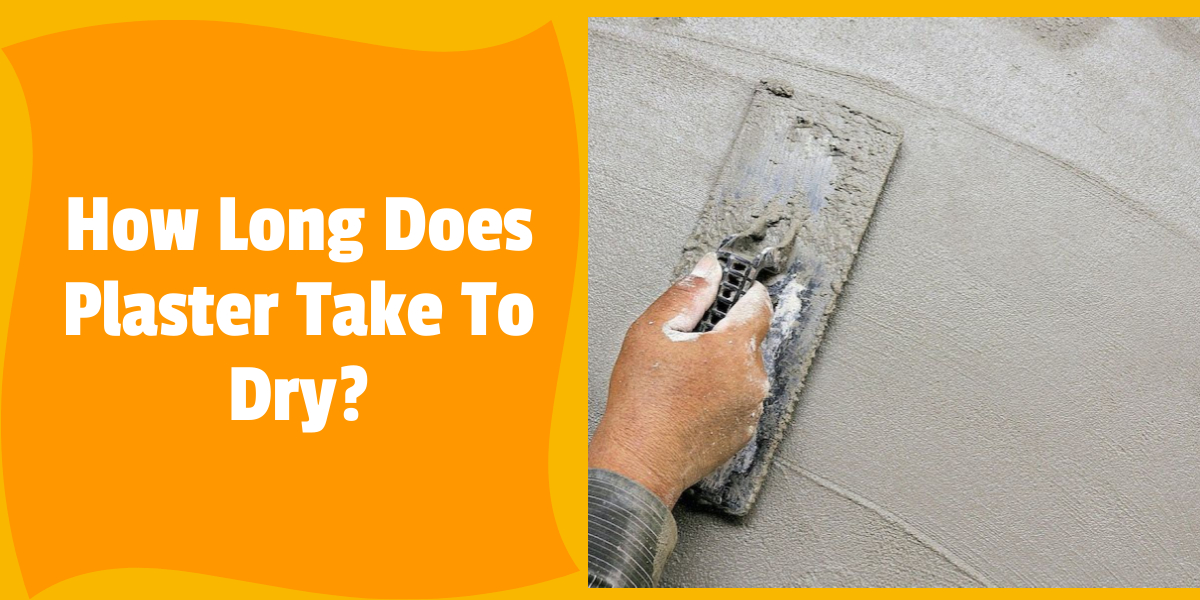
Plaster drying time is among the most critical factors to consider anytime you are plastering your property. This drying time dictates how long it takes you to finish renovating your house since it can potentially delay the application of successive layers as well as the painting of the plaster.
Failure to allow the plaster to dry properly can negatively affect the quality of the overall resultant job. In this article, we will thoroughly look at all elements regarding plaster drying and the revamping of your property.
See also: Caulk Before Or After Painting?
Contents
- The Essence Of Allowing The Plaster To Dry
- What Are The Factors Affecting Coat Plaster Drying Times?
- How Do I Know If The Fresh Plaster Is Dry?
- Drying Times For Different Plastering Types
- What Is The Impact Of Weather On Plaster Drying Times?
- What Is The Difference In Appearance Between Wet And Dry Plaster?
- What Causes Plaster Crack While It Is Drying?
- Why Is My Plaster Not Drying?
- How To Tell If Plaster Is Dry Enough To Paint?
- FAQs
- How long for plaster to dry before painting?
- Is it necessary to mist-coat new plaster?
- How long does it take for plaster to dry during the winter?
- How to speed up plaster drying?
- Can I spend a night in a freshly plastered room?
- How long should I leave the plaster before I decorate?
- How soon can I paint after skimming?
The Essence Of Allowing The Plaster To Dry
In the event that you are planning to paint your recently plastered walls immediately, it is critical to ensure that they are completely dry before you paint them.
Most paint brands will seal the exterior of the wall. Therefore, in the event that your walls are moist when you start painting them, there will be condensation, creating room for moisture to accumulate within the structure of your wall.
What Are The Factors Affecting Coat Plaster Drying Times?
As discussed earlier, there are no specified drying times for plastering since it depends on several factors, including but not limited to:
- Underlying temperatures
- Moisture levels
- The presence or absence of a plasterboard
- The number of plaster layers applied
How Do I Know If The Fresh Plaster Is Dry?
Throughout the painting process, the plaster will undergo several stages. It will appear crumbly and feel bone dry. After the paint application, the plaster will turn dry and rubbery. Then, as it undergoes the painting process, it will turn pale pink before turning dark brown.
If a dark brown colour persists with no visible grains after painting, then the plaster is dry and well set.
Patches darker than the rest of the wall might result from the plaster layer being thicker in certain wall spots or low temperatures that could be impacting the drying time. This indicates that the plaster wall needs a longer drying time.
See also: Best Masking Tape For Painting
Drying Times For Different Plastering Types
Plastering comes in a variety of forms that can be applied in a variety of situations. The approximate drying times for each form of plastering are shown in the table below.
Type of Plaster | Use | Setting Time | Coverage per 25kg bag |
Base Filler | Filling cracks and small holes | 1-2 hours | N/A |
One Coat or Patching plaster | Patching large areas | 3 -4 hours | 2.25 Sqm @ 13mm thickness |
Board finish Plaster | Top coat for plasterboard & Dry-Coat | 1.5 Hours | 10 Sqm @ 2mm thickness |
Multi-finish Plaster | Top coat for most backing surfaces | 1.5 hours | 10 Sqm @ 2mm thickness |
Dry-coat Plaster | Used for resurfacing areas with a new DPC | 1.5 Hours | 3.25 Sqm @ 11mm thickness |
Tough-coat Plaster | High strength under coat | 1.5 Hours | 3.25 Sqm @ 11mm thickness |
Hardwall Plaster | High impact under coat | 1.5 – 2 Hours | 3.0 Sqm @ 11mmthickness |
Browning Plaster | Under coat for highly absorbent surfaces | 1.5 – 2 Hours | 2.75 Sqm @ 11mm thickness |
Bonding Plaster | Under coat for use on masonry | 1.5 – 2 Hours | 2.75 Sqm @ 11mm thickness |
What Is The Impact Of Weather On Plaster Drying Times?
Typically, plastering will dry faster during the summer compared to the winter.
Humidity levels are higher in cold weather, and temperatures are generally lower, which naturally regulates moisture. Hot weather is very likely to damage a plastering project. It is therefore recommended that you try to keep the temperatures as low as possible. Plaster typically takes an additional one to two days to dry in the winter.
Conversely, if a recently skimmed wall comes into contact with direct sunlight, it can result in cracks in your plastering.
Fundamentally, an expert plasterer will always be cognizant of the underlying weather and try to maintain as low a temperature as possible. It is vital to continuously keep track of the plaster’s drying times and ensure that it dries properly.
What Is The Difference In Appearance Between Wet And Dry Plaster?
As the plaster dries, its colour becomes lighter. This change in colour should tell you that the drying process is progressing correctly. When you plaster during the summer, leave the windows open. This ensures that there is enough heat for gradual drying. Such plaster should be left to dry for a few additional days before painting for the best outcomes.
In the event that you are not certain about the appearance of dry plaster, look for a creamy pink colour. Conversely, an earthy or brown colour is an indication that the application might not be properly dry. Unless you are experiencing problems with dampness, as will be discussed later, your plaster should start showing dry patches after 24 hours. Later, these patches will increase in size until the application is eventually dry.
What Causes Plaster Crack While It Is Drying?
Cracks in drying plaster are caused by a few factors. One of the reasons is excessive heat. Other causes of cracks are the failure to remove the wallpaper before plastering, the use of expired products, or incorrect plaster mixture ratios.
Why Is My Plaster Not Drying?
In the event that you have waited for more than a week and the plaster seems not to have dried up, it may indicate a problem. There could be a damp penetration or leak that necessitates further investigation.
Plaster always dries up naturally. Therefore, if plaster retains wetness with visibly dark patches, this could be an indication that there is a problem that needs to be addressed instead of using heat to force it to dry up.
See also: Best Paint For Tiles
How To Tell If Plaster Is Dry Enough To Paint?
One simple remedy is to leave the plaster for a week in a properly ventilated room. However, plaster could dry out sooner; this is because plaster drying times vary significantly as a result of external factors that include underlying humidity and temperature levels. Typically, the plaster will dry in three to four days under favourable conditions and should be left to dry naturally whenever possible.
When you are conducting a visual inspection, you will realize that once the plaster sets, it turns a mid-brown colour and then a light salmon colour as drying continues.
FAQs
How long for plaster to dry before painting?
You should leave the plaster to dry for at least three to four days before painting. An undercoat should be left to dry for at least a week before applying the final plaster layer.
Is it necessary to mist-coat new plaster?
Yes. A mist coat refers to diluted paint that soaks into the plaster and enhances outcomes when using undiluted emulsion to paint.
Applying a mist coat potentially improves bonding, which effectively prevents the paint from peeling or flaking. Leave the mist coat to dry for at least 24 to 48 hours prior to applying the topcoat.
How long does it take for plaster to dry during the winter?
Plaster work done during the winter typically requires 50% more drying time compared to plasterwork carried out during ordinary weather. You should wait at least 12 to 14 days prior to applying the topcoat.
How to speed up plaster drying?
Maybe, maybe not. Low-temperature levels combined with proper ventilation are helpful in speeding up the drying process. However, whenever possible, be sure to leave doors and windows open to facilitate airflow in a freshly plastered room.
You can turn on your indoor heating system in the event that the temperature in the room does not reach the required drying temperature. For instance, if the best temperature is 25 degrees, then a heater can help you match this temperature.
Turning up too much heat is not recommended since it can overspeed the drying process, which might result in cracks.
Can I spend a night in a freshly plastered room?
Recently plastered walls do not release any dangerous fumes. However, they hold significant amounts of moisture. This moisture content gives the room a damp feel. Therefore, it is advisable to wait a couple of days before you can sleep in a freshly plastered room.
However, if you are painting or wallpapering the newly plastered wall, it is important to leave it until it is completely dry. The wall is best positioned for painting or wallpapering when it is completely dry. Once the paintwork and decorations are done, you do not have to think about relocating furniture for a long time until it is time to redecorate.
How long should I leave the plaster before I decorate?
There are a number of factors to consider when deciding how soon you can apply paint to your new plastering project. Typically, plaster takes up to a month to dry perfectly. However, you can speed up plaster drying time by keeping doors and windows open or turning up the heat in your room.
How soon can I paint after skimming?
According to expert recommendations, it is good to wait for at least seven days before considering painting newly skimmed walls. However, you may preferably wait for three to four weeks if the plaster is extraordinarily thick.



